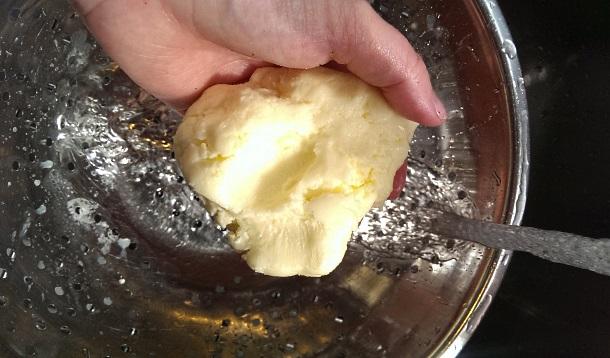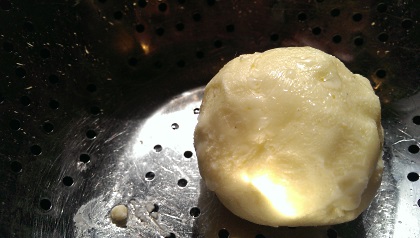
Have you ever wondered how to make whipped cream or butter? Most people take the two products for granted and it never crosses their minds about how it's made, except that it comes from dairy and maybe butter-making requires a churn like you've seen at the Cracker Barrel on some trip to Florida. Many people don't even realize that the biggest difference between whipped cream and butter is the amount of time you've spent making it.
![]() RELATED: How To Make An Easy Vegan Coconut Whipped Cream
RELATED: How To Make An Easy Vegan Coconut Whipped Cream
Why would you want to make butter, you might ask? Why would you not? Butter's the not-so-secret miracle food of the restaurant industry, baking, and southern cooking, which is how people like Paula Deen get mighty famous, y'all. And some people use a lot of butter. Also, it's a great science and history project for kids. It's like asking why you'd climb Everest. You have to make butter, if only once, just because you can.
Butter's an amazing food. From a scien-historical standpoint, butter (and its kin in cheese) are shelf-stable, preserved milk products that can sit without refrigeration. That's right. You don't have to let all your butter sit in the refrigerator, hard and cold. It's quite safe to leave a half a stick or so out on the counter in a butter dish for your daily toastmaking - as long as it's salted.
Salt, you see, is a natural preservative.
The pioneers had butter, man. You think they carried fridges in their covered wagons? NOPE. But they did have salt.
I digress. You're here to learn how to make butter. In fact, you might already have seen some homesteader 101's info on making butter with a stand mixer. But maybe you don't know why it works. Or whether you can make it without a stand mixer. Maybe you don't know that you make whipped cream practically the same way.

Milk is composed mostly of water, lactose (milk sugar), proteins, and fats. When you make cheese, cheese is an (eventual) product that starts with a chemical reaction that involves the proteins in milk. Butter and whipped cream, on the other hand, are all about the fat. Both are made from cream, and cream is the high-fat milk product that results when you let fresh milk (straight from the cow) sit until it separates. The less-dense fat molecules rise to the top, like ice in a glass.
The fats in cream that make butter are triglycerides. You can envision them like an egg sitting in water: they’re normally suspended in milk because the triglycerides are encapsulated by a thin shell made up of a bit of protein, cholesterol, and molecules called phospholipids. The phospholipids have a unique structure–a “head” that is hydrophilic (water-attracting) and a tail that is hydrophobic (water-repelling)–that causes it to form a triple-layer bond that keeps the triglycerides happily floating around in their little egg shapes, separate from the liquid water in milk and one another.
You can damage that phospholipid layer with brute force.
When you begin to whip cream that has a high enough fat content (ideally, about 35%), as when you whip anything, you're forcing air into the mixture. After a brief period of whipping, the few exposed triglycerides (which hate water and will refuse to mix with it) will begin to attach to each other, thickening the mixture. A little bit more whipping, and the hydrophobic triglycerides will begin to attach to air instead, holding it. After a period of a couple of minutes when you're using a mixer, you will have stiff peaks, and that's where you need to stop--if you're making whipped cream.
Do you have to have a mixer to make whipped cream? The answer is: nope! You can make whipped cream in a jar (especially nice, because it's self-contained). Pour your cream in, add a little sugar or vanilla if you want, seal the jar, and send the kids to go play maracas with it. When it stops sloshing around so much, open up the jar and check it out.

But whipped cream is a long way from butter, you argue. And sure, it looks that way.
![]() RELATED: The Simple Trick For Light and Fluffy Whipped Cream Every Time
RELATED: The Simple Trick For Light and Fluffy Whipped Cream Every Time
As you keep agitating the cream past the whipping cream stage (you'll want a mixer and not a jar for butter-making), the phospholipid layers are destroyed, exposing more and more of of the triglycerides, which continue to bond to each other in order to keep from mixing with liquid. The clumps of fat grow ever larger, squeezing out the air again, until suddenly you are left with solid lumps of the fats sitting in liquid--butter sitting in its own buttermilk.
PS - the last stage is a little messy, so I recommend using the splash guard.

With cold, clean hands, you can pack these fats together in a larger clump (and pour the buttermilk through a sieve to salvage it--it's good stuff!). Take the lump over to a bowl of ice water, or run it under the cold tap, and knead the butter tightly together into a firm lump. This "washing" process will squeeze the last of the buttermilk out, leaving you with very little liquid in the finished product (ideally, less than 20%).
The more liquid you can squeeze out of it, the better your butter is.

Once your butter is as dry as you can make it, you can knead salt into it and shape it into pats, if you have a butter press! Or if you want a special (southern) treat, whip room-temperature butter with some honey for a dinner-roll spread that your guests won't soon forget.
I recommend you keep your first attempts at homemade butter in the fridge or freezer when you're not using it, because your butter is likely to have a higher water content than commercially made butter (especially if it wasn't packed in a press) and probably not enough salt to render it shelf-stable for long enough to use it all up.